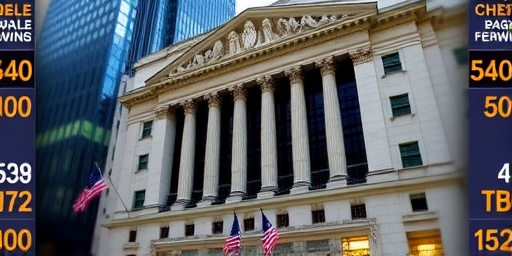In a resounding vote of confidence from American shoppers, U.S. retail sales for November surged beyond economists’ expectations, propelling the Dow Jones Industrial Average to a remarkable 500-point gain on Wednesday. The data, released by the U.S. Census Bureau, showed a 0.8% increase from October, adjusted for seasonal variations, far outpacing the forecasted 0.3% rise. This unexpected strength in consumer spending has ignited optimism across Wall Street, even as lingering concerns about inflation and potential interest rate hikes loom large.
The Dow’s climb marked its largest single-day percentage increase in over a month, closing at 37,250 points after opening the session with cautious trading. Investors, buoyed by the retail figures, shifted focus from geopolitical tensions to the resilience of the U.S. economy. ‘This is a clear sign that consumers are not backing down despite higher prices,’ said Sarah Thompson, chief economist at Horizon Investments. ‘The stock market is rewarding that durability today.’
November Retail Sales Breakdown: E-Commerce and Auto Sales Lead the Charge
Diving into the specifics, the November retail sales report painted a picture of vigorous holiday season kickoff. Total sales reached $709.3 billion, up 0.8% from the previous month and 8.9% year-over-year. E-commerce continued its dominance, with online retailers posting a 1.2% monthly gain, driven by early Black Friday promotions and aggressive discounting from giants like Amazon and Walmart. ‘Cyber Monday alone generated over $10 billion in sales, a record high,’ noted Nielsen analyst Mark Rivera, highlighting how digital platforms are reshaping consumer habits.
Automobile sales also contributed significantly, rising 1.5% as supply chain bottlenecks eased and incentives lured buyers back to dealerships. General merchandise stores saw a 0.9% uptick, while food services and drinking places, including restaurants, climbed 1.1%, reflecting a return to dining out post-pandemic. However, not all sectors shone equally; gasoline stations dipped 0.2% due to stabilizing fuel prices, and sporting goods retailers experienced a modest 0.4% decline amid shifting seasonal demands.
Excluding volatile categories like autos and gas, core retail sales still advanced 0.5%, underscoring broad-based consumer spending momentum. This core figure is particularly watched by the Federal Reserve as it gauges underlying economic health. Compared to pre-pandemic levels, November’s sales are 15% higher, a testament to the U.S. consumer’s adaptability in the face of economic headwinds.
Dow Jones Rally Ignites: Tech and Retail Stocks Take Center Stage
The Dow Jones index’s surge was not isolated; the broader stock market joined the festivities, with the S&P 500 rising 1.2% and the Nasdaq Composite gaining 1.5%. Retail and consumer discretionary stocks were the clear winners. Shares of Target Corporation jumped 4.2%, while Best Buy soared 3.8% on reports of strong electronics demand. Amazon’s stock climbed 2.9%, buoyed by speculation of blockbuster holiday quarters.
Financial heavyweights in the Dow also benefited. JPMorgan Chase added 2.1% as traders bet on sustained economic growth supporting lending activity. Even defensive plays like Procter & Gamble edged up 1.3%, indicating a risk-on sentiment permeating the market. ‘The Dow Jones is reacting to the idea that retail sales data could delay Fed rate cuts, keeping yields attractive for banks,’ explained Wall Street veteran Lisa Chen from Goldman Sachs Research.
Volume trading hit 12 billion shares, above the recent average, as institutional investors piled in. Options activity spiked in consumer staples ETFs, with call volumes surging 40% pre-market. This rally erased much of the Dow’s losses from the prior week’s volatility, triggered by overseas conflicts and election uncertainties. Year-to-date, the Dow is now up 12%, outpacing many global benchmarks.
Consumer Spending Resilience Amid Economic Storm Clouds
Despite the positive data, the backdrop for this consumer spending boom is anything but straightforward. Inflation remains sticky at 3.2% year-over-year, per the latest Consumer Price Index, squeezing household budgets. Yet, wage growth has held steady at 4.1%, providing a buffer for many middle-income families. ‘Americans are prioritizing essentials but still splurging on experiences and deals,’ said University of Chicago economist Dr. Elena Vasquez in an interview. ‘This hybrid spending pattern is what’s keeping the economy afloat.’
Unemployment sits at a low 3.7%, and household savings rates, though down to 3.8% from pandemic highs, are channeling into discretionary purchases. Credit card debt has risen 7% annually, but delinquency rates remain subdued at 2.5%. The retail sales uptick comes against a backdrop of robust job additions—248,000 in November alone—further bolstering confidence. However, experts caution that holiday spending could strain finances if discounts dry up in December.
Regionally, sales were strongest in the South and West, up 1.1% and 0.9% respectively, fueled by population growth and tourism rebounds. Urban centers like New York and Los Angeles reported double-digit gains in luxury retail, while rural areas lagged slightly, emphasizing urban-rural consumption divides. Small businesses, per National Retail Federation data, captured 28% of sales, a nod to the sector’s post-COVID recovery.
- Key Drivers: Early holiday promotions, wage gains, and eased supply chains.
- Challenges: Rising interest rates on 22% of consumer debt and potential tariff impacts.
- Opportunities: Green energy incentives boosting appliance sales by 6%.
This resilience in retail sales is a counterpoint to global slowdown fears, with Europe’s consumer confidence dipping amid energy crises. U.S. shoppers’ willingness to spend signals a decoupling from international woes, at least for now.
Market Implications: Fed Policy Shifts and Holiday Outlook
As the stock market digests this data, eyes are on the Federal Reserve’s December meeting. Strong retail sales could temper expectations for aggressive rate cuts, with futures now pricing in a 75% chance of a 25-basis-point reduction in March rather than January. Fed Chair Jerome Powell, in recent remarks, emphasized data-dependency: ‘Robust consumer spending is a double-edged sword—it supports growth but complicates our inflation fight.’
Looking ahead, economists forecast December retail sales to accelerate to 1.2%, propelled by Christmas and year-end clearances. The National Retail Federation projects total holiday spending at $936 billion, a 4% increase from 2023. Retailers like Macy’s and Kohl’s are ramping up inventory, with AI-driven personalization expected to lift conversion rates by 15%.
For the Dow Jones, sustained consumer momentum could push it toward 38,000 by quarter’s end, per Bloomberg consensus. However, risks abound: A hotter-than-expected jobs report next week or renewed Middle East tensions could reverse gains. Investors are also monitoring corporate earnings season, starting with retail bellwethers. ‘If consumer spending holds, we’re looking at a soft landing scenario,’ opined Morningstar strategist Mike Patel. ‘But vigilance is key amid policy uncertainties.’
Beyond immediate trades, this data underscores the U.S. economy’s pivot toward service-led growth, with implications for global supply chains. As tariffs loom under potential new administrations, importers are front-loading purchases, adding to November’s strength. Forward, sustainable retail sales growth will be pivotal in shaping 2025’s economic narrative, potentially averting recessionary fears and sustaining the stock market‘s bull run.
In summary of broader trends, the interplay between Dow Jones performance and retail sales metrics will continue to guide investor sentiment. With Black Friday weekend sales already topping $9.8 billion, the holiday stretch promises more volatility but also opportunity. Economists urge households to budget wisely, while businesses eye expansion. The path forward hinges on balancing festive exuberance with fiscal prudence, setting the stage for a dynamic year ahead in American commerce.









